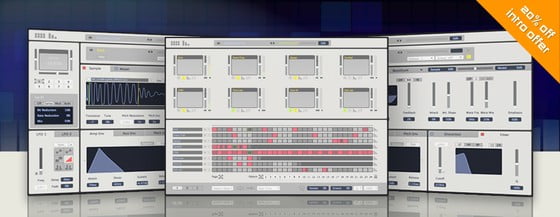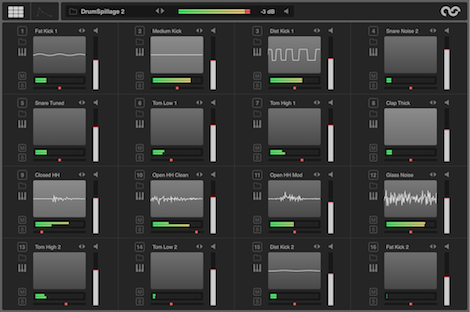

This button offers the first clue to DrumSpillage's true synth engine, which can be explored in greater depth by clicking the pad edit button above the pads in the top-left hand corner. These include setting root note and key ranges for each pad (so sounds can overlap or remain limited to one key), changing envelope attack and release via an X-Y axis and switching on global modules for the synth engine which lies behind each pad. Staying on the "pad" page, the four buttons to the left of each pad offer general edit parameters.

The "function" button offers a drop-down menu, the two most important commands within which allow you to load a sound for each pad from DrumSpillage's own Factory library, or jump into Edit mode, of which more shortly. The blue on black livery isn't the most welcoming either but, if you can see beyond these first impressions, DrumSpillage quickly begins to offer its sonic personality. Each pad can be triggered directly from the interface and is flanked by four buttons to the left, volume and pan sliders to the left and right and hard-to-see solo and "function" buttons above. Each is untitled in this default kit and the initial visual impression isn't great, as the interface is dark and brooding. From the off, these all generate their own sounds, which are mapped from C1 upwards. The plug-in offers two views, the first of which is a rather dark, imposing set of 16 pads. The plug-in has been available for over a year but refinements have kept coming, with DrumSpillage becoming more appealing with each new set of developments. DrumSpillage is a 64-bit plug-in made by AudioSpillage and while this name might be less familiar than some of those listed above, it certainly deserves to deflect some attention away from the big boys.
Audiospillage elecktroid mac#
Roger Linn and Dave Smith's forthcoming Tempest drum machine is due in the summer and follows this path, but if anticipation is proving too much and you're running a Mac system hosting AU plug-ins, read on. It's more rare to find a product whose sound sources are created entirely in the electronic domain. The majority of drum libraries are precisely that libraries which are stocked with sampled hits to allow you to configure your own construction kits. Native Instruments' Maschine and Battery products, BFD and Superior Drummer's libraries of multi-sampled "real" kits and Spectrasonics' Stylus RMX represent the tip of the iceberg, as the list of options goes on long after the beats themselves have stopped.
Audiospillage elecktroid mod#
I would love to find one of those and mod it for trigger inputs (something I should do to the SR-88).Beat-making is such an essential part of music production, irrespective of the genre you favour, that it is no surprise that the market is saturated with drum plug-ins of one type or other. I hadn't used mine in years until this week (turns out the problem all along had been a loose wire on the battery clip that wasn't loose enough to LOOK loose but was loose enough to cause aggravation of sound and disorder of rhythm) so I couldn't remember the polarity of the adapter it needs to run it on mains power, and when I was on VSE looking for that I saw this in the comments:

Wow, so funny, I had/have those same esoteric things as you do in the pic! Our MPCs are even the same color! There's also a Roland EF303 around that could kind of count as a drum machine I guess, but it's extremely basic.

MPC2000xl is pretty much the heart of my whole setup and has been for years but I'm deliberately taking a break from it to focus on getting tight with the minimal, live synth rig I put together over the summer. Done of the drum machines I've got is actually set up right now, things are in a kind of transitional phase.


 0 kommentar(er)
0 kommentar(er)
